
by Leslie Moldenauer | | Essential Oils
I have had so many messages lately about general confusion surrounding essential oil use for children. Is it safe? Is it dangerous? Somewhere in between?
Children are much more sensitive to essential oils and aromas in general, but they can also benefit greatly from their therapeutic uses. There are a number of things that parents need to know before using them to ensure the safety of their child. Looking up a blend or recipe online is not the best way to use your oils. Let’s cover a few things that you may or may not already know in order to keep your little ones safe.
Overall the immune system of a child is much more immature than that of an adult, therefore they are much less likely to be able to handle adverse reactions, even diffusing for long periods can be overwhelming to them. Keep in mind that until a child reaches the age of 5, on average (from experience) they are not going to be able to express that they are feeling “off” if you are diffusing an anti-germ blend of too long in the home, as one example.
What we do know is that babies have an immature nervous system, integumentary system, and liver.
*Rather than me just telling you this and you take it at face value, PLEASE, I encourage you to read further on these topics from these references in which I came to my findings above:
*Tisserand, R., Young, R. (2014) Essential Oil Safety (2nd Ed) Elsevier: London, UK. (p47)
*Leung, A., Balaju, S., Keswani, S., (2013) Biology and Function of Fetal and Pediatric Skin.
21(1): 1-6. Retrieved from https://www.ncbi.nlm.nih.gov/pmc/articles/PMC3654382/
*Eye and Vision Development. Retrieved from
http://www.healthofchildren.com/E-F/Eye-and-Vision-Development.html
*Nervous System Development (2014) Retrieved from
https://www.thevisualmd.com/health_centers/child_health/infant_nutrition/
nervous_system_development
In light of all of this, avoiding the use of essential oils for infants and babies under a few months of age both via topical application and inhalation is probably best. Work with/ask a qualified aromatherapist for more information. In regards to topical use of essential oils, many are not recommended dermally under two years of age. This does NOT, however, equate to never use essential oils under two, a bit of a misunderstanding of Tisserand’s most recent book published in 2014.
Diffusing Essential Oils
So if topical use is not the best way for a young child, what is? Inhalation is the ideal method of use for young children. This does not mean however that you should turn on the diffuser and leave it on all day. I do not recommend diffusing for longer than a period of one hour without taking a break for older children, in line with Tisserand’s recommendations. Younger children can benefit from a conservative 10-20 minutes before taking a break. In order to explain possible reasons for this, let’s talk a little bit about our sense of smell, or our olfactory system.
Through my courses at the American College of Healthcare Sciences I learned that, “Our sense of smell goes through five stages, those are: detect, transmit, perceive, analyze, and store. These stages cycle incredibly fast. The reception area of our olfactory system is called the olfactory epithelium. The olfactory epithelium is the size of a small postage stamp in each nostril, and is packed with an impressive 40 million sensory neurons, capable of detecting .0000000013 of an ounce of a scent in a single breath of air” (ACHS, Aroma 101).
Mind-boggling isn’t it! Our olfactory system is so incredibly efficient, that obtaining the therapeutic benefits of these amazing oils happens quickly. Certain oils are stronger than others as well and can be overwhelming diffused for long periods of time, therefore always be sure to diffuse in a well-ventilated room. To receive maximum benefit and not waste your precious oils, diffuse around small children for short periods of time as mentioned above. Please make note, nebulizers are very different than diffusers. Nebulizers are MUCH stronger than your average diffuser. In this instance, I do not recommend following the times listed above, it would be much too aggressive of a treatment.
Topical Application
You can begin to apply oils topically over the age of two, but dilution amounts are very important. Never use oils topically undiluted, or what some call “neat”. This greatly increases your risk for skin irritation and skin sensitization. Contrary to what you may have been told, skin irritation is not a detox reaction.
(See more details here in an article written by Kristina Bauer a.k.a. The Untamed Alchemist)
Special Considerations
If your child suffers from epilepsy, asthma, an autoimmune disorder, or cancer, you should contact a qualified aromatherapist. Not all oils will cause the same reactions for everyone; please do not navigate this for yourself. (Always let your doctors know that you are utilizing aromatherapy for your children. Same goes for herbs, homeopathy, etc.)
Essential oils are potent, it is crucial that you keep them out of reach of children. I have seen pictures online of small babies or small children handling bottles of oil. It is not cute, nor safe to let them hold them. Your children should know from a very young age that essential oils are medicine, and not for their little hands.

Now being an aromatherapist, I certainly do not want to discourage you from using essential oils with your children. I use the following methods on my boys and have for years (now 7 and 9): topically, in a diffuser, in a steam tent, in an aromastick, in a bath, a lotion, a salve, and more. We have some go to oils for supporting a good night’s rest, ones that bring support to the respiratory system when the need arises, help with bumps and bruises, ones that bring comfort, and oils that provide overall support to their bodies own innate healing process.
You will find camps of people that say never use essential oils on children, and others who throw caution to the wind and say that all oils are safe to use on children. My beliefs are not in line with either camp. Essential oils are not an always or never modality. When you follow proper safety guidelines, you can utilize essential oils and know that you are doing the best for your children.

Like so many practices in life I encourage you to become educated on the proper use of essential oils. When using them, please do so cautiously, understanding that there is often misinformation on the internet. You can be assured that I support only educated and proven resources. While essential oils should not be feared they should be respected and used properly to ensure the safety of the individuals using them.
Please note that I am not a medical practitioner. The content of this website is provided for general informational purposes only and is not intended as, nor should it be considered a substitute for, professional medical advice. Do not use the information on this website for diagnosing or treating any medical or health condition. If you have or suspect you have a medical problem, promptly contact your professional healthcare provider. By using this website, you assume full responsibility and liability for your own actions.
References and Resources
https://www.aromaceuticals.com/blog/adverse-reactions-to-peppermint-oil
http://www.aromaweb.com/articles/diffu.asp
http://tisserandinstitute.org/essential-oils-and-the-detox-theory/
http://wegotreal.com/essential-oil-concerns-robert-tisserand/
http://roberttisserand.com/2014/05/essential-oil-dilution-important/
http://www.aromahead.com/blog/2009/08/02/essential-oil-chemistry-oils-high-in-18-cineole/
American College of Healthcare Sciences (2012) Aroma 101 (p 185)
Tisserand, R., Young, R. (2014) Essential Oil Safety (2nd Ed) Elsevier: London, UK. (p47)
Leung, A., Balaju, S., Keswani, S., (2013) Biology and Function of Fetal and Pediatric Skin.
21(1): 1-6. Retrieved from https://www.ncbi.nlm.nih.gov/pmc/articles/PMC3654382/
Eye and Vision Development. Retrieved from
http://www.healthofchildren.com/E-F/Eye-and-Vision-Development.html
Nervous System Development (2014) Retrieved from
https://www.thevisualmd.com/health_centers/child_health/infant_nutrition/
nervous_system_development
BEFORE YOU GO! Remember to sign up for my FREE Facebook group! Hang out with me and THOUSANDS of other Essential Oil lovers looking to learn, click on to join Real Essential Oil Education Group!
Check out my FREE offer below!
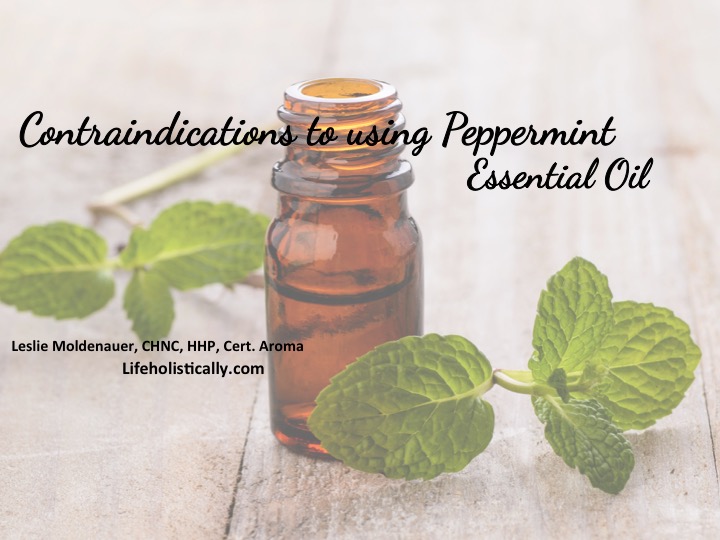
by Leslie Moldenauer | | Essential Oils
Essential oils are powerful concentrated extracts and knowing how to use them is of the utmost importance. Essential oils should not be feared but they should be respected and used properly to ensure the safety of the individuals using them. Let’s talk about the safety of Peppermint (Mentha piperita) essential oil.
The list of therapeutic actions of Peppermint essential oil is quite impressive; its most talked about action is helping with stomach discomfort. Peppermint in an enteric-coated capsule is actually very efficient in the treatment of IBS [1] and can be purchased over the counter (OTC), but placing a drop in water will not reap the same desired results. Peppermint can be found in the marketplace in soap, shampoo, cigarettes, toothpaste, chewing gum, tea, ice cream and more. Due to the fact that Peppermint oil is widely used as a food additive and an ingredient in OTC herbal preparations, many people feel that peppermint falls into the “safe” category for adults and children alike. It’s important to understand that Peppermint oil is used in minuscule quantities in these applications and is not the in the same form as the essential oils on your shelf, therefore, consuming a few drops of pure Peppermint essential oil daily gives you a much higher dose, and is not recommended for a variety of reasons.
I am not going to cover the many uses of the oil; today I want to cover safety. It is important for all essential oil users to know that Peppermint essential oil comes with what are called contraindications.
What does contraindication mean?
According to the Merriam Webster dictionary, a contraindication “is something (such as a symptom or condition) that makes a particular treatment or procedure inadvisable” [2].
In aromatherapy, these are specific instances when an oil should not be used because it might be harmful, for example, anyone with a history of seizures, asthma, blood clotting disorders, taking certain medications or are pregnant or nursing to name a few. There are certain oils not recommended for children for various reasons. Some oils increase the risk of skin irritation when applied topically (more so for those with sensitive skin), while other oils are phototoxic.
What types of contraindications does Peppermint essential oil have? Peppermint essential oil contains a significant amount of the constituent menthol. When the menthol in Peppermint is inhaled, it stimulates the TRPM8 cold receptors in the lungs. This could potentially trigger a reflex in young children making breathing slow, and for this reason, Peppermint essential oil has been given the contraindication, “do not apply near the face of infants or children.” [3][4].
It has been stated that Peppermint essential oil can be used topically on children to lower fever. We can now see that this is not recommended near the face (the chest/neck would apply here). Peppermint does provide a cooling “effect”, but has not been proven to actually lower fever. A great alternative is to place the herbal counterpart into a muslin bag and place into a lukewarm bath. (I typically place the bag in boiling water first to sufficiently fill the water with mint, and then add to the bath). If the fever is high the mildly warm water will help bring the fever down albeit temporary to help bring comfort, and the herbal water will be incredibly soothing to the child. Best of all, it is safe.
Fevers are the bodies natural response to fighting infection, in most cases reducing fever is not recommended. Just try to make the child comfortable. Please speak to your doctor in regards to a safe upper limit for a fever before using interventions to lower it such as NSAIDS. Refer to this article here, speaking in greater detail about fevers in children.
“Peppermint essential oil disturbs the cytochrome P450 liver detoxification system, which means that it can interfere with the metabolism of certain drugs. It is established that the oil is contraindicated with the use of cardiac stabilizing medications, including quinidine. It appears to interfere with calcium channel blockers and has been anecdotally reported to increase the activity of NSAIDS and naproxen”.-Katharine Koeppen, Aromaceuticals.com [5].
Peppermint essential oil “may” interfere with breastfeeding by lowering milk supply. There is no scientific evidence to back this claim up, but there is sufficient anecdotal evidence to warrant me to include it in this article. Please proceed with caution if you are nursing.
Peppermint essential oil should be used with caution when taken orally improperly (under the tongue or in water), with those suffering from gastroesophageal reflux disease (GERD), as it can exacerbate the condition. This is because “Peppermint oil can relax the sphincter between the stomach and esophagus, allowing stomach acids to flow back into the esophagus” [6].
According to the Expanded German Commission E Monographs, “oral ingestion of Peppermint essential oil is not recommended for anyone with liver damage (potentially elevating liver enzymes), gallbladder inflammation, and obstruction of bile ducts” [7].
If using Peppermint essential oil on the skin, it is important to dilute it as it carries a moderate risk for skin irritation. Essential oils should not be used undiluted on the skin or “neat”, in most cases.
This information is not provided to induce fear. Peppermint is often shared for use online for a myriad of ailments, and the truth is it is an impressive oil with many benefits, but there are safety concerns as well. When armed with this information, you can make an informed decision about how essential oils can benefit you and your family.
References:
[1] Enteric-coated peppermint-oil capsules in the treatment of irritable bowel syndrome: a prospective, randomized trial. Retrieved from https://www.ncbi.nlm.nih.gov/pubmed/9430014
[2] Contraindication definition. Retrieved from https://www.merriam-webster.com/dictionary/contraindication
[3] TRPM8: The Cold and Menthol Receptor, Retrieved from
https://www.ncbi.nlm.nih.gov/books/NBK5238/
[4] Tisserand, R., Young, R. (2014) Essential Oil Safety. (2nd ed) Elsevier
[5] Koeppen, K. Adverse Reactions to Peppermint Oil
[6] Peppermint. University of Maryland Medical Center. Retrieved/updated December 19, 2017 from: https://umm.edu/health/medical/altmed/herb/peppermint
[7] Blumenthal, M. (2000). Herbal medicine: expanded commission E monographs. Austin: Integrative Medicine Communications (p301)
Additional Resources
Application of gas-liquid chromatography to the analysis of essential oils. Part XVII. Fingerprinting of essential oils by temperature-programmed gas-liquid chromatography using capillary columns with non-polar stationary phases. Analytical methods committee. Retrieved from https://www.ncbi.nlm.nih.gov/pubmed/9463975
Bowles, E. J. (2004). The chemistry of aromatherapeutic oils. Crows Nest, N.S.W.: Allen & Unwin.
Schultz, et.al. (1998) Rational phytotherapy: A physicians guide to herbal medicine. New York: Springer
Like so many practices in life I encourage you to become educated on the proper use of essential oils. When using them, please do so cautiously, understanding that there is often misinformation on the internet. You can be assured that I support only educated and proven resources. While essential oils should not be feared they should be respected and used properly to ensure the safety of the individuals using them.
Please note that I am not a medical practitioner. The content of this website is provided for general informational purposes only and is not intended as, nor should it be considered a substitute for, professional medical advice. Do not use the information on this website for diagnosing or treating any medical or health condition. If you have or suspect you have a medical problem, promptly contact your professional healthcare provider. By using this website, you assume full responsibility and liability for your own actions.
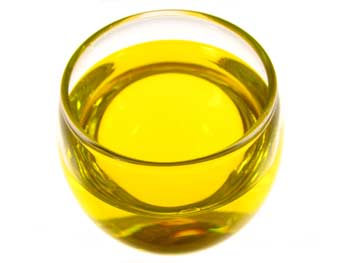
by Leslie Moldenauer | | Body, Essential Oils
Do you have dry skin? Do you like massages? Do you use essential oils? Then you should familiarize yourself with the many carrier oils at your disposal. Carrier oils are fixed oils. They are pressed from the fatty portions of a plant (seeds, nuts, kernels) and unlike essential oils can go rancid over time. They nourish the skin as they have many nutrients and fatty acids, and they are essential to use when using essential oils for topical application.
Some carrier oils are odorless, light and penetrate the skin quickly while others can be overwhelming in an aromatherapy blend and leave an oily residue on the skin.
It is important to know the shelf life of your carrier oil and remember to always store in a dark cool spot.
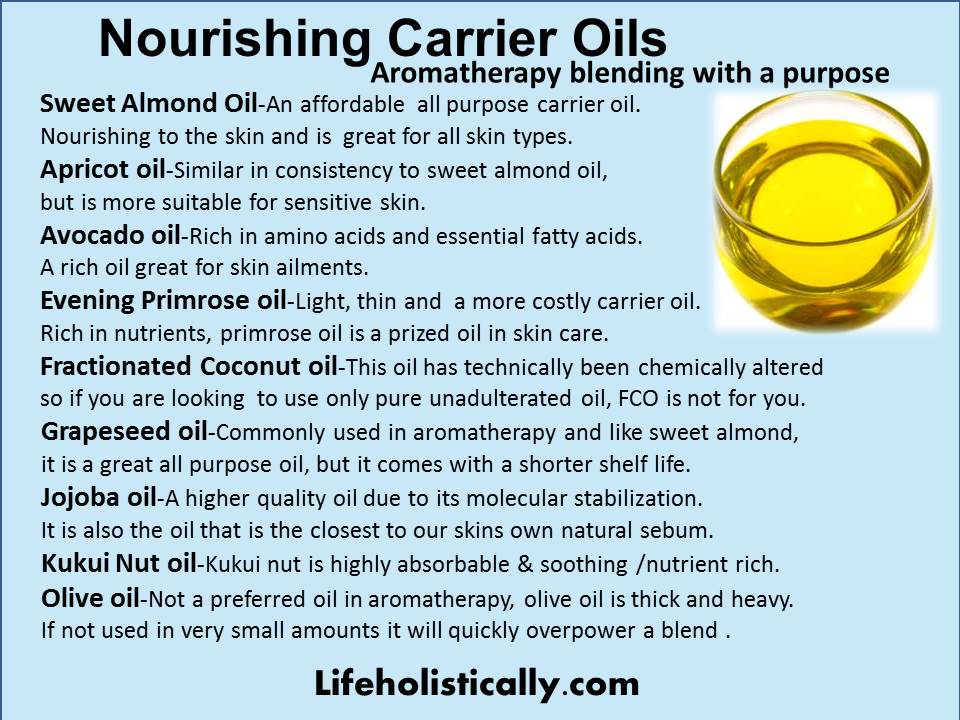
Part II

Most everyone has a favorite carrier oil. Which one to use will depend on what you are trying to accomplish. I could not possibly pick just one, or even three favorites. I have at least 50% of these carrier oils at my disposal, and the more you use them the easier it will be to instinctively know which one to grab when making a product.
If you have any additional questions, feel free to contact me. I am happy to help!
If you are interested in purchasing a carrier oil to try, Mountain Rose Herbs has a large variety of carrier oils, as well as essential oils, herbs and more. (Carrier oils are under ingredients) Click here to be redirected.
**Please note this is a affiliate link. I have chosen only Mountain Rose Herbs to be an affiliate as I stand behind their phenomenal products. For those unfamiliar…rest assured you will not pay any more for your product by using this link.
Please note that I am not a medical practitioner. The content of this website is provided for general informational purposes only and is not intended as, nor should it be considered a substitute for, professional medical advice. Do not use the information on this website for diagnosing or treating any medical or health condition. If you have or suspect you have a medical problem, promptly contact your professional healthcare provider. By using this website, you assume full responsibility and liability for your own actions.
Additional Resources/Recommendations
The Aromatherapy Beauty Guide by: Danielle Sade
Power of the Seed by: Susan Parker
Liquid Sunshine by: Jan Kusmirek

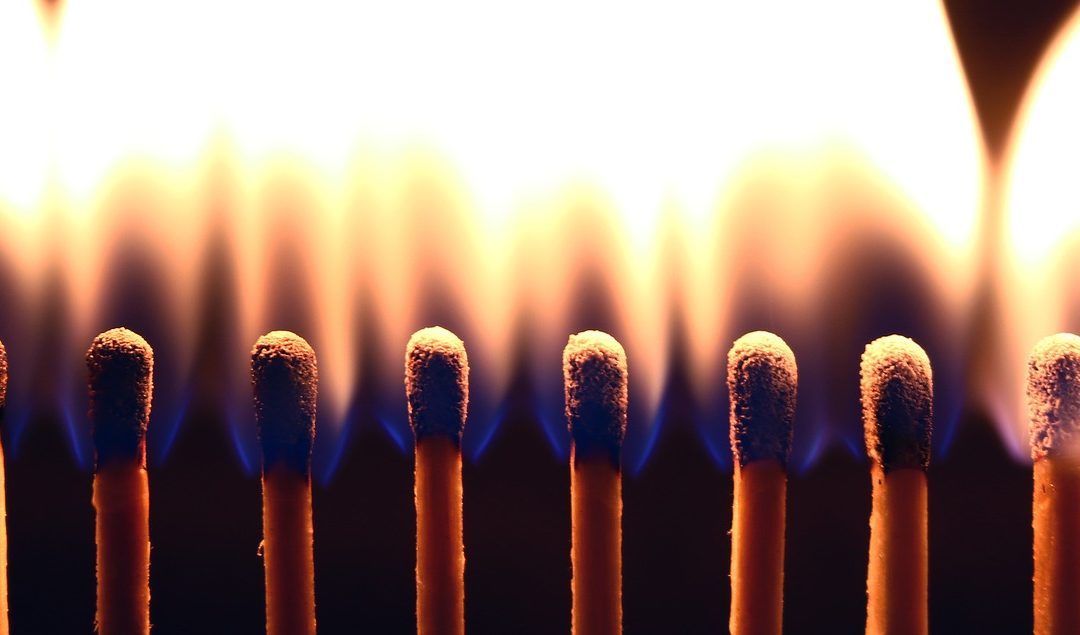
by Leslie Moldenauer | | Essential Oils, Food
Are you walking around on a low simmer? The good news is, once we understand what causes inflammation and see how quickly our actions can either fan or cool the flames, we can begin to make better choices every day that bring us back into balance.
Inflammation found in the body is typically a normal and healthy response to injury or to defend against foreign invaders. When the inflammation is due to an injury, sometimes we can visually see it, and sometimes we can feel it when the skin is hot to the touch as well as experience the pain that comes along with it. This heat is the body’s way of getting more nourishment and more immune activity (WBC) into an area that needs to fend off infection or heal (1). But inflammation isn’t always helpful. In great amounts over a long period of time, it can be a real problem. Whole-body inflammation is a chronic, low-level inflammation. Evidence shows that over time this kind of systemic inflammation sets the stage for many serious diseases including but not limited to rheumatoid arthritis, fibromyalgia, stroke, several cancers, lupus, migraines, dementia, Chron’s disease, and heart disease (2).
Would you be surprised if I told you that most of this systemic inflammation starts in your gut? Intestinal bloating, frequent bouts of diarrhea or constipation, gas and pain, heartburn and acid reflux are early signs of an inflamed digestive tract. Keep in mind these are the early signs and they should not be ignored.
See, your gut is where more than 2/3rds of your immune system is; it was designed to eliminate viruses and bacteria in your food before they infect your body. If your gut is inflamed it can’t properly fight off virus and bacteria; leading to inflammation, malabsorption of nutrients, and what is coined leaky gut syndrome, or intestinal permeability. Rease more about this here (Source)
Why do so many of us have this type of inflammation? The modern diet has the majority of us eating an upside-down ratio of fatty acids (omega-3, -6, and -9), too much sugar and carbs, and high levels of wheat, dairy, and other common allergens.
Let’s pull this apart a little bit.
- Sugar-Sugar can seem almost impossible to avoid since it is in just about everything. Many products would surprise you. I recommend watching the documentary That Sugar Film (Free live streaming with Amazon Prime)..it is eye opening. High sugar products like sodas, fruit drinks, candies, pastries, etc. should be avoided. Even grains should be monitored as they turn to sugar and raise blood sugar levels in the body rather quickly. Some healthy substitutes for sugar include stevia (pure), honey, and blackstrap molasses. Keep in mind even these healthy alternative raise blood sugar levels, so moderation is key.
- Oils-Most polyunsaturated vegetable oils like safflower, sunflower, corn, peanut and soy, are high in linoleic acid, an omega-6 essential fatty acid that is actually PRO-inflammation. I recommend healthier fats such as coconut or ghee when cooking.
- Gluten/Refined Grains– For many of us, if not all of us, gluten is the wicking that lights a fire of inflammation in our body. Anyone suffering from celiac disease knows how inflammatory wheat can be. The kicker is that many more people likely suffer from an intolerance than true celiac disease. Many do not have the more common symptoms, which are gut symptoms like diarrhea, constipation, and bloating. Systemic simmering of inflammation can show itself in many other ways….or it can be somewhat silent. Have you ever heard the phrase: “Inflammation-The Silent Killer?” We know there is much controversy as to why wheat is such an issue. It is not my intention to try to convince you what I believe, but I will say I know a number of people who can eat bread and pasta in Italy with no issue, but come home to very different reactions to “America’s wheat”. Food for thought.
- Dairy– One of the most inflammatory foods, second only to gluten. It causes inflammation in a large percentage of the population, resulting in digestive issues such as bloating, gas, constipation, and diarrhea. You do not need to be lactose intolerant for dairy to cause inflammation in your body. Dairy that is raw or not heat pasteurized can be very different then conventional dairy in regards to is health benefits as well as reactions in the body. For these reasons, my family tries to stay away from conventional dairy as much as possible.
- Meat-Not all meats are created equal. Organic antibiotic free grass-fed meat is the only meat I recommend. Conventionally raised animals are fed GMO grains, pumped full of antibiotics and as a result, the meat is extremely high in the inflammation-promoting Omega 6, rather than the Omega 3 rich pasture raised counterpart. Do not be tricked by food labeling, look for 100% grass-fed and organic.
Another big cause of chronic inflammation in the body is…..CHRONIC UNRELENTING STRESS! When you are under chronic stress and cortisol is constantly flowing at high levels, your immune system lowers and you are more susceptible to illness and you guessed it—chronic inflammation. We all need to work to naturally decrease inflammation in the body and minimize stress.

I will not cover these in this particular article, but there are other causes of inflammation in the body such as: overuse of antibiotics, infection, and hormonal imbalances. Here is an article that goes into more detail about these areas.
So how do we decrease inflammation in the body?
1.Consume more olive oil, fish, and nuts. The Mediterranean-style diet based on fruits, vegetables, nuts, and olive oil (organic) can lower inflammation. The reason being is the high amount of omega-3 fats in these foods. Omega-3 fats bring the inflammation down- omega-6 raises it, fuels it. Read more here on the anti-inflammatory benefits of Omega 3’s (3).
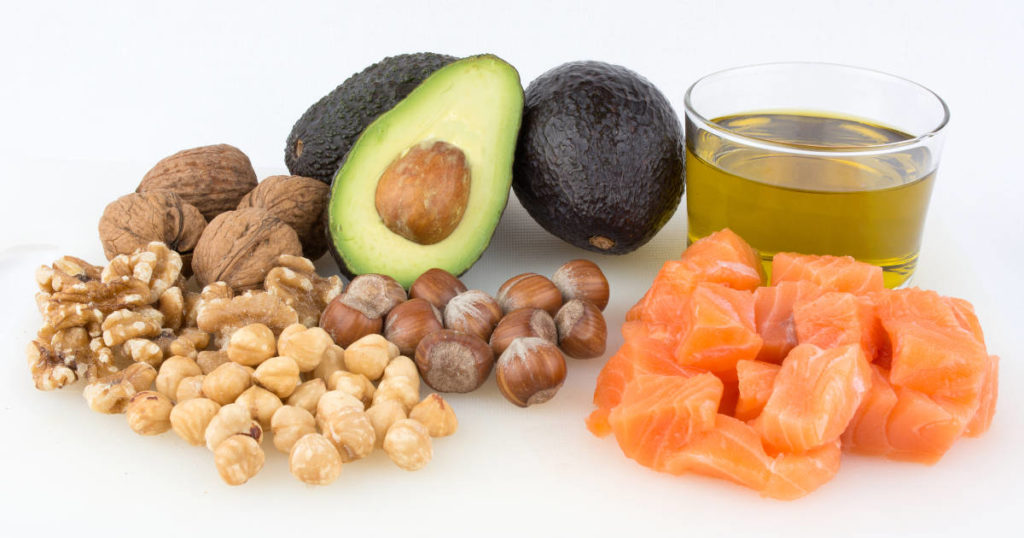
Photo Credit: Everynutrient.com
2.Get active. Exercise a great way to lower inflammation without any side effects. Our bodies were meant to be active!
3.Get enough sleep. Some reports state to get a minimum of 7 hours of sleep a night. That is a good goal.
4.Reduce stress. High levels of stress hormones can lead to the release of excess inflammatory chemicals. Stress reduction is perhaps more important than any other thing I have mentioned, even above your diet. Essential oils can go a long way to assist in calmer moods, but working hard on handling what is important and leaving the rest behind is something to work towards every day.
Here is one of my favorite blends to help calm me. This amount of drops is suitable for a 400ml water reservoir diffuser, adjust accordingly:
Lavender Lavandula angustifolia 4 drops
Ylang ylang Cananga odorata 3 drops
Sweet Marjoram Origanum majorana 2 drops
Neroli Citrus aurantium 1 drop
Herbs to focus on. Incorporating turmeric, ginger, holy basil, cinnamon, cayenne, and garlic into your daily diet is important to combat inflammation. (As I do not know your medical history, make sure you do not have any contradictions to these herbs before consuming)
Remember, sometimes you may not have what is considered typical ‘symptoms’ of chronic inflammation. If you are a pain sufferer or are suffering any disease’ ending in ‘itis’, you need to address the inflammation in your body.
If you think you might have a food sensitivity, I recommend going on an elimination diet for two weeks to see how you feel. You may find that avoiding certain foods restores more than just your digestive health. Countering chronic inflammation takes a combination approach because it arises from a combination of causes. The great news is we have so much more control than we realize — if we understand how our choices affect our health, we can do something about it. Knowledge is power-to your health!
References
(1) Inflammation: Causes, Symptoms & Anti-Inflammatory Diet. Retrieved from https://www.livescience.com/52344-inflammation.html
(2) Chronic, Subtle, Systemic Inflammation. Retrieved from https://www.painscience.com/articles/inflammation-chronic-subtle-systemic.php
(3) Omega-3 Fatty Acids. Retrieved from https://www.umm.edu/health/medical/altmed/supplement/omega3-fatty-acids
Please note that I am not a medical practitioner. The content of this website is provided for general informational purposes only and is not intended as, nor should it be considered a substitute for, professional medical advice. Do not use the information on this website for diagnosing or treating any medical or health condition. If you have or suspect you have a medical problem, promptly contact your professional healthcare provider. By using this website, you assume full responsibility and liability for your own actions.

by Leslie Moldenauer | | Body, Essential Oils
Peppermint Whipped Body Butter Recipe. You will be amazed how easy this recipe is to make, and it smells good enough to eat. Here is what you will need:
-1c cocoa butter (Use refined if allergies are common in the home/for who will be using the body butter)
-1/2c coconut oil (unrefined)
-1/2c almond, olive, or jojoba oil
-10-30 drops of either peppermint, lavender, or sweet orange essential oil (or another favorite)
Combine all ingredients in a saucepan under very low heat until cocoa butter and coconut oil are melted.

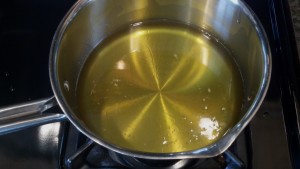
Remove from heat, let cool slightly and place in refrigerator for a minimum of an hour, until it starts to become solid. (If you do not let cool enough, it will take MUCH LONGER for your fluffy peaks)….and you will tire of mixing, I assure you….been there…done that.
Use a hand mixer and whip for a good 10 minutes or until fluffy peaks form. Add essential oils during this mixing process.
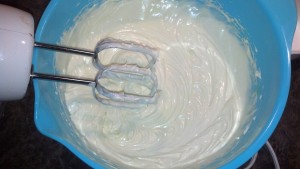
Place into glass jars. Return to fridge to set.
That is it, super simple. You will LOVE it. This is divine, better than anything you will find in the store. This recipe will make about 2 cups of butter. If you want to make a larger batch for your friends (they make great gifts) add a capsule or two of pure vitamin E oil as a preservative. Avoid dl-alpha-tocopherol, the synthetic form which has been genetically modified and is not safe.
Make note that just as coconut oil liquefies when in warmer temperatures, typically above 76 degrees, your butter will soften as it gets warmer. Store in a cool location and if it becomes too soft, place back into fridge…or mix again with a mixer if necessary. Enjoy your creation!! <3

Please note that I am not a medical practitioner. The content of this website is provided for general informational purposes only and is not intended as, nor should it be considered a substitute for, professional medical advice. Do not use the information on this website for diagnosing or treating any medical or health condition. If you have or suspect you have a medical problem, promptly contact your professional healthcare provider. By using this website, you assume full responsibility and liability for your own actions.
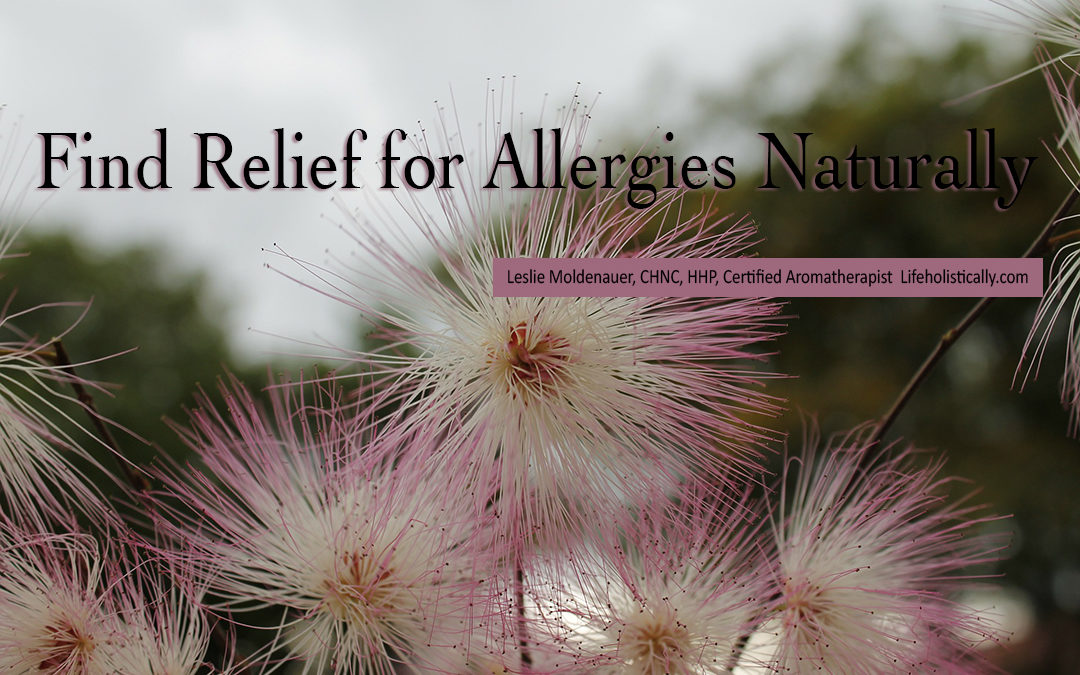
by Leslie Moldenauer | | Essential Oils, Homeopathics
The dreaded allergy season is almost upon us, although for some allergies are not just one season. Are you a sufferer or know someone who is? For people with common hay fever and allergies, these pollutants can bring on symptoms ranging from a minor annoyance, to continuous, annoying postnasal drip to a full-scale, coughing sneezing-itchy-eyed allergy attack. I would consider my allergies to be moderate, but I have a friend who has to take not just one, but multiple OTC remedies just to do yard work, and he still suffers greatly. Researchers think nasal allergies affect about 50 million people in the United States and is quickly growing [1]. These numbers are daunting, what can we do about it?
I recommend trying some of the things below before dosing yourself OTC remedies that tend to cause a lot of drowsiness. Not everything will work for everyone, but my family has had much success in avoiding taking anything OTC by doing the following (I included links to the products for your convenience):
Homeopathic remedies– Like desensitization therapies, homeopathy users consume low doses of a natural substance. The difference is that the substance in homeopathy is related to the symptoms as opposed to the allergen source. I have one for myself and one for my children. The one I take is called Allergy Relief by Homeostasis Labs. At the first sign of itchy eyes or nose, I chew 2 tablets and I am good for four hours. My allergies are considered moderate. (I combine this with other things which I will discuss below) I have two different go-to’s for my kids. The first is Kid’s Relief Allergy. It works quickly for them with their sneezing and runny nose. The second is D-Hist Jr. by Ortho Molecular products, a very reputable supplement company. This supplement contains (Vitamin C, quercetin dihydrate, stinging nettles, bromelain and N-acetyl-cysteine). THis tackles my boys stronger allergen responses, I have taken it before as well with great success
Quercetin– Quercetin is a naturally-derived bioflavonoid that helps stabilize cells and prevents them from releasing histamine. Quercetin also is a natural antioxidant that helps clean up molecules called free radicals that cause cell damage, which can lead to health woes and premature aging [2]. Citrus fruits, onions, apples, parsley, tea, tomatoes, broccoli, lettuce, and wine are naturally high in quercetin, but allergy sufferers will most likely need to use supplements to build up enough of this compound to prevent attacks. The recommended dosage is about 1,000 milligrams a day, taken between meals. It’s best to start treatment six weeks before allergy season. Those with liver disease shouldn’t use quercetin, so please consult your doctor before using this or any other supplement — especially if you are pregnant or nursing. Read more about this bioflavonoid and its contraindications here. (Very important to know before consuming this day-to-day, be sure it is safe for you)
Stinging Nettle Urtica dioica– This powerful herb is highly anti-inflammatory. If you are handling this plant fresh do be sure to use gloves and long shirt as protection as there is a reason for its name, avoid the sting. Research has shown that consuming nettles in freeze-dried capsules effectively reduces histamine levels in the body, thus reducing inflammation of affected tissues [3]. Even drinking this in a tea can be very effective.
I keep a box of these lozenges in my purse when pollen season begins to help with the scratchy itchy throat and post nasal drip. FInd them here. They are gluten-free and contain (Stinging nettle leaf, European elderflower, plantain leaf, eyebright, honey, and a bit of menthol.
Saline Nasal Rinses– A mainstay in our home, I use the neti pot every day as part of a routine, not just during allergy season. My kids have a version they use too. It is critical to remove the pollen from your sinus cavity. (It is great during cold and flu season too) Regular rinses (2-3 times a day during peak times) can flush away allergens, reduce nasal symptoms and help prevent infection. If this is too drying for you, stick to once a day. You also can use a neti pot before bed to ‘help’ prevent snoring caused by allergies and promote optimal overnight breathing (Not guaranteed to nix the snore). Neti Pot /Rinse and Sinu Cleanse Kid’s Mist kit.
You can utilize hydrosols in the neti pot, rosemary is by far the most popular recommendation, but unless I am truly fighting an impending infection, I stick to pink Himalayan sea salt. Please NO essential oils in your neti pot.
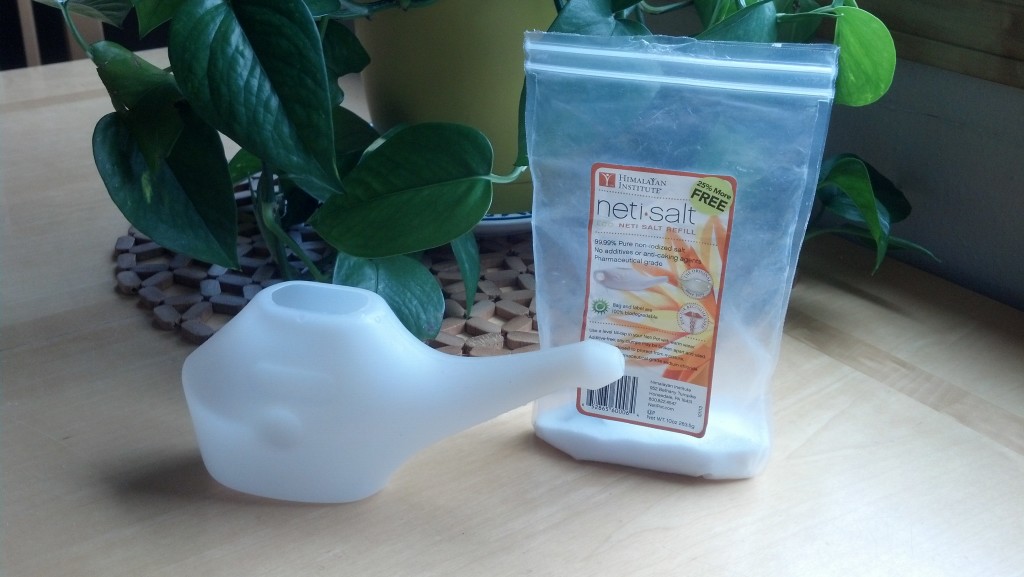
Essential OIls-You didn’t think I would end this article without talking about essential oils! I have a number of favorites here, like the formulation below. Make sure your blend contains an oil that has strong anti-inflammatory properties to help open the nasal passageways, one that provides anti-histamine properties, and possibly one to provide you with a decongestant, expectorant or mucolytic properties, depending on what your symptoms are. Here is one of my favorites:
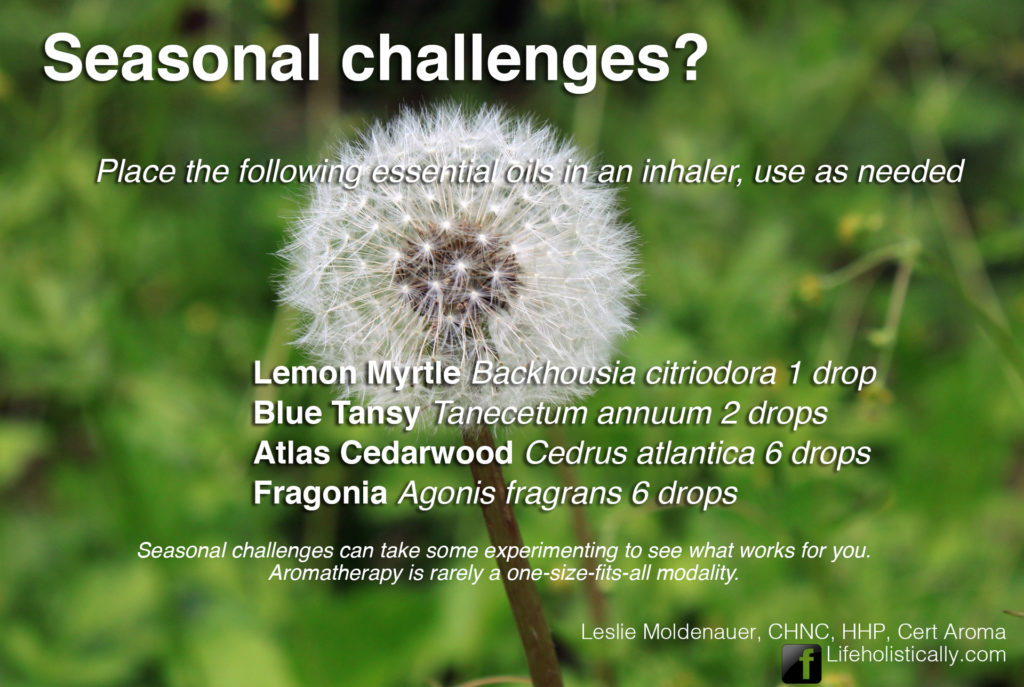
As the meme states, aromatherapy is rarely a one size fits all modality. Make sure that you have no contraindications for this blend, and if you don’t, give it a try in an inhaler when needed.
Always keep in mind that when outdoors the pollen will stick to you, your hair and your clothes. Be sure to wash your hair and clothes before sitting on a chair/couch or before lying in your bed.
Hopefully, some of these things will help you enjoy the springtime….step out and enjoy the warmer weather my friends!
References
[1] Allergy Facts and Figures. Retrieved from http://www.aafa.org/page/allergy-facts.aspx
[2] What are Free Radicals? Retrieved from https://www.livescience.com/54901-free-radicals.html
[3] Colley, L. (2016) Healing Allergy Inflammation with Stinging Nettle. Retrieved from http://www.organiclifestylemagazine.com/healing-allergy-inflammation-with-stinging-nettle

Please note that I am not a medical practitioner. The content of this website is provided for general informational purposes only and is not intended as, nor should it be considered a substitute for, professional medical advice. Do not use the information on this website for diagnosing or treating any medical or health condition. If you have or suspect you have a medical problem, promptly contact your professional healthcare provider. By using this website, you assume full responsibility and liability for your own actions.






















